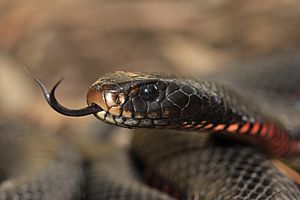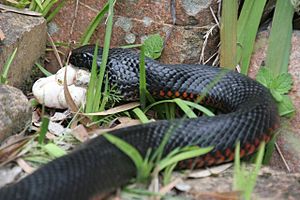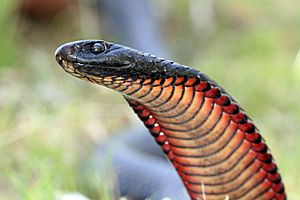Red-bellied black snake facts for kids
Quick facts for kids Red-Bellied Black Snake |
|
|---|---|
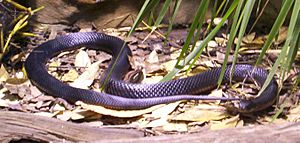 |
|
| Red-bellied Black Snake at Brisbane Forest Park, Brisbane, Queensland, Australia |
|
| Scientific classification | |
| Kingdom: | |
| Phylum: | |
| Class: | |
| Order: | |
| Suborder: | |
| Family: | |
| Genus: |
Pseudechis
|
| Species: |
P. porphyriacus
|
| Binomial name | |
| Pseudechis porphyriacus Shaw, 1794
|
|
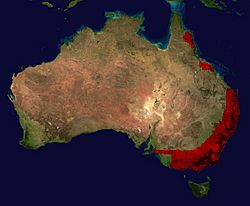 |
|
| Range of Red-Bellied Black Snake (in red) | |
The red-bellied black snake (Pseudechis porphyriacus) is a species of venomous snake in the family Elapidae. The species is endemic to Australia. It is one of eastern Australia's most commonly encountered snakes.
Averaging around 1.25 m (4 ft 1 in) in length, it has glossy black upperparts, bright red or orange flanks, and a pink or dull red belly.
It is not an aggressive species and generally retreats from encounters with people, but can attack if provoked. Although its venom is capable of causing significant illness, no deaths have been recorded from its bite, which is less venomous than other Australian elapid snakes.
Common in woodlands, forests and swamplands, the red-bellied black snake often ventures into nearby urban areas.
It forages in bodies of shallow water, commonly with tangles of water plants and logs, where it hunts its main prey item, frogs, as well as fish, reptiles, and small mammals.
Contents
Description
The red-bellied black snake has a glossy black top body with a light-grey snout and brown mouth, and a completely black tail. It lacks a well-defined neck; its head merges seamlessly into the body.
Its flanks are bright red or orange, fading to pink or dull red on the belly.
The red-bellied black snake is on average around 1.25 m (4 ft 1 in) long, the largest individual recorded at 2.55 m (8 ft 4 in). Males are generally slightly larger than females.
The red-bellied black snake can have a strong smell, which some field experts have used to find the snakes in the wild.
Like all elapid snakes, it is front-fanged.
Scalation
The number and arrangement of scales on a snake's body are a key element of identification to species level.
The red-bellied black snake has 17 rows of dorsal scales at midbody, 180 to 215 ventral scales, 48 to 60 subcaudal scales (the anterior—and sometimes all—subcaudals are undivided), and a divided anal scale. There are two anterior and two posterior temporal scales, and the rostral shield is roughly square-shaped.
Distribution and habitat
The red-bellied black snake is native to the east coast of Australia, where it is one of the most commonly encountered snakes. It can be found in the urban forest, woodland, plains, and bushland areas of the Blue Mountains, Canberra, Sydney, Brisbane, Melbourne, Cairns, and Adelaide. The Macquarie Marshes mark a western border to its distribution in New South Wales, and Gladstone in central Queensland marks the northern limit to the main population. To the south, it occurs across eastern and central Victoria, and extends along the Murray River into South Australia. Disjunct populations occur in the southern Mount Lofty Ranges in South Australia and in North Queensland.
The red-bellied black snake is most commonly seen close to dams, streams, billabongs, and other bodies of water, although they can venture up to 100 m (350 ft) away, including into nearby backyards. In particular, the red-bellied black snake prefers areas of shallow water with tangles of water plants, logs, or debris.
Behaviour
Red-bellied black snakes can hide in many places in their habitat, including logs, old mammal burrows, and grass tussocks. They can flee into water and hide there; one was reported as staying submerged for 23 minutes. When swimming, they may hold their full head or the nostrils above the water's surface. At times, they may float without moving on the water surface, thus looking like a stick.
Within their habitat, red-bellied black snakes appear to have ranges or territories with which they are familiar and generally remain within. Within their territory, they may have some preferred places to reside.
The red-bellied black snake is generally not an aggressive species, typically withdrawing when approached. If provoked, it recoils into a striking stance as a threat, holding its head and front part of its body horizontally above the ground and widening and flattening its neck. It may bite as a last resort. It is generally active by day, though nighttime activity has occasionally been recorded. When not hunting or basking, it may be found beneath timber, rocks, and rubbish or down holes and burrows.
Snakes are active when their body temperatures are between 28 and 31 °C (82 and 88 °F). They also thermoregulate by basking in warm, sunny spots in the cool, early morning and rest in shade in the middle of hot days, and may reduce their activity in hot, dry weather in late summer and autumn.
Rather than entering true hibernation, red-bellied black snakes become relatively inactive over winter, retreating to cover and at times emerging on warm, sunny days. Their dark colour allows them to absorb heat from sunshine more quickly.
Reproduction
In spring, male red-bellied black snakes often engage in ritualised combat for 2 to 30 minutes, even attacking other males already mating with females. They wrestle vigorously, but rarely bite, and engage in head-pushing contests, where each snake tries to push his opponent's head downward with his chin.
The male seeks out a female and rubs his chin on her body, and may twitch, hiss, and rarely bite.
Pregnancy takes place any time from early spring to late summer. Females become much less active and band together in small groups in late pregnancy. They share the same retreat and bask in the sun together.
The red-bellied black snake gives birth to live young in individual membranous sacs, after 14 weeks' gestation, usually in February or March.
The young, numbering between eight and 40, emerge from their sacs very shortly after birth, and have an average length around 12.2 cm (4.8 in). Young snakes almost triple their length and increase their weight 18-fold in their first year of life, and are mature when they reach a snout-vent length of 78 cm (31 in) for males or 88 cm (35 in) for females. Females can breed at around 31 months of age, while males can slightly earlier.
Red-bellied black snakes can live up to 25 years.
Feeding
The diet of red-bellied black snakes primarily consists of frogs, but they also prey on reptiles and small mammals. They also eat other snakes, including those of their own species. Fish are hunted in water. Red-bellied black snakes may hunt on or under the water surface, and prey can be eaten underwater or brought to the surface. They have been recorded stirring up substrate, possibly to disturb prey.
As red-bellied black snakes grow and mature, they continue to eat the same size prey, but add larger animals, as well. Although they prefer live food, red-bellied black snakes have been reported eating frogs squashed by cars.
Venom
Early settlers feared the red-bellied black snake, though it turned out to be much less dangerous than many other species. It accounted for 16% of identified snakebite victims in Australia between 2005 and 2015, with no deaths recorded.
Bites from red-bellied black snakes can be very painful—needing pain relief medication and result in local swelling, prolonged bleeding, and even local necrosis, particularly if the bite is on a finger.
It is the most commonly reported species responsible for envenomed dogs in New South Wales.
Conservation and threats
The red-bellied black snake is considered to be a least-concern species according to the International Union for Conservation of Nature.
Captivity
One of the snakes commonly kept as pets in Australia, the red-bellied black snake adapts readily to captivity and lives on a supply of mice, though it can also survive on fish fillets, chicken, and dog food.
Images for kids
See also
 In Spanish: Serpiente negra de vientre rojo para niños
In Spanish: Serpiente negra de vientre rojo para niños


